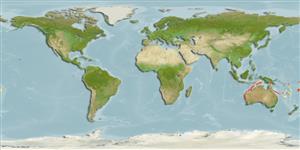Klassifizierung / Names
Namen | Synonyme | Catalog of Fishes(Gattung, Arten) | ITIS | CoL | WoRMS | Cloffa
>
Perciformes/Scorpaenoidei (Scorpionfishes) >
Platycephalidae (Flatheads)
Etymology: fulviguttatus: Name from the Latin word meaning ‘orange or brown spots’, refers to this species’ characteristic spots on the head and body..
Environment: milieu / climate zone / depth range / distribution range
Ökologie
seewasser benthopelagisch; tiefenbereich 126 - 248 m (Ref. 86254). Subtropical
Eastern Indian Ocean to Western Pacific: Australia.
Size / Gewicht / Alter
Maturity: Lm ? range ? - ? cm
Max length : 26.6 cm SL Männchen/unbestimmt; (Ref. 86254)
Kurzbeschreibung
Morphologie | Morphometrie
Rückenflossenstacheln (insgesamt): 9 - 11; Rückenflossenweichstrahlen (insgesamt): 11-12; Afterflossenweichstrahlen: 11 - 12. This species is distinguished by the following characters: 99-113 anteroventrally slanted oblique scale rows above lateral line; snout length 30.4-34.8% HL, markedly decreasing proportionally with growth; pectoral fin length 14.6-16.5% SL; pelvic fin length 20.9-25.7% SL; nasal bone without tubercles; dorsal surface of head and body pale brown, with small, round brown spots; pelvic fin with small brown spots (Ref. 86254).
Life cycle and mating behavior
Geschlechtsreife | Fortpflanzung | Ablaichen | Eier | Fecundity | Larven
Imamura, H. and M.F. Gomon, 2010. Taxonomic revision of the genus Ratabulus (Teleostei: Platycephalidae), with descriptions of two new species from Australia. Memoirs of Museum Victoria 67:19-33. (Ref. 86254)
IUCN Rote Liste Status (Ref. 130435)
Bedrohung für Menschen
Harmless
Nutzung durch Menschen
Mehr Information
NamenSynonymeMetabolismusRäuberÖkotoxikologieFortpflanzungGeschlechtsreifeAblaichenSpawning aggregationFecundityEierEientwicklung
Alter/GrößeWachstumLänge-GewichtLänge-LängeLängenhäufigkeitenMorphometrieMorphologieLarvenLarven Pop.Dyn.RekrutierungDichteBRUVS
ReferenzenAquakulturAquakultur ProfilZuchtlinienGenetikElectrophoresesVererbbarkeitKrankheitenVerarbeitungNutrientsMass conversion
PartnerBilderStamps, Coins Misc.LauteCiguateraGeschwindigkeitSchwimmstilKiemenoberflächeOtolithsGehirngrößeSehfähigkeit
Tools
Zusatzinformationen
Download XML
Internet Quellen
Estimates based on models
Preferred temperature (Ref.
123201): 14.9 - 22.5, mean 20.3 °C (based on 26 cells).
Phylogenetic diversity index (Ref.
82804): PD
50 = 0.5625 [Uniqueness, from 0.5 = low to 2.0 = high].
Bayesian length-weight: a=0.00525 (0.00246 - 0.01120), b=3.04 (2.85 - 3.23), in cm total length, based on LWR estimates for this (Sub)family-body shape (Ref.
93245).
Trophic level (Ref.
69278): 3.8 ±0.7 se; based on size and trophs of closest relatives
Widerstandsfähigkeit (Ref.
120179): mittel, Verdopplung der Population dauert 1,4 - 4,4 Jahre. (Preliminary K or Fecundity.).
Fishing Vulnerability (Ref.
59153): Low vulnerability (22 of 100).
